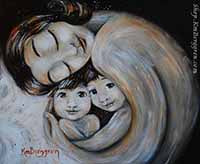
Blurry Art Prints
KATIE BERGGRENDid you receive an art print from an artist that looks blurry or mushy? Or just doesn’t feel like high-quality? You should be able to see the texture of the paint or even of the canvas on a good quality print.
(However, it DOES depend upon the size of the print you purchased AND on the size of the original painting that the print was made from, and the type of art the print was created from - ink pour, painting, pastel, colored pencil. If you can't see the texture of the paint or the canvas, that does NOT mean something is wrong with the print.)
But we can feel when an image feels sharp, and when it feels a little pixelated.
If you are purchasing an 8x8 inch archival print of a painting that was created as a 40x40 inch piece on canvas, then you will probably not see the texture of the paint or the canvas in the print. The image has been reduced so that the texture is not visible. The print should still be gorgeous and clear and sharp, though.
And your purchased art print should NEVER have a watermark! Watermarks are only for images used in online sharing.
On the other hand, if you are purchasing a 12x12 inch art print of a piece that was originally created as an 8x8 inch painting on canvas, you SHOULD see some texture of the paint and even the canvas (depending upon the style of the art and how much paint the artist uses).
In either print size and no matter what size the original art was (which most of the time you will not know, anyway, because it doesn't matter), a fine art print that you paid for in physical form should NOT be blurry, even though the size was increased, because an artist who is creating professional prints would have a very large image of the painting saved. The large image allows for large high-quality prints. If your image IS blurry, see below.
Here is some more detail about image quality:
When a photograph of an art piece is snapped, it needs to be the highest resolution photo as possible. Photos from a smartphone may have high resolution, but suffer in other ways. Learn about how Art Prints are made.
The image is then transferred from the camera to the computer. Images on the computer screen can be kept in high-resolution, straight from the camera, or reduced into low-resolution. Learn about screen-resolution images.
Resolution refers to the amount of pixels within a square inch. An image on a screen is low-resolution (or screen resolution… think social media, blogs, websites) which means fewer pixels in a inch square, so that it loads quickly.
The artist reserves (or should!) a high-resolution image on their computer (many pixels per square inch) that is used for printing the actual art print, or products featuring the art such as mugs, t-shirts, and art water bottles. The better-quality image they have, the more and larger sizes of prints they can create.
We artists protect our high-resolution images, back them up, keep them from the internet. Once the original painting has sold and shipped, these high-res images are all we have to work with, for years to come, to make at prints or products.
As a consumer, an art-buyer, a gloriously appreciated art collector, your printed art print that you receive from the artist, should NOT be blurry unless that is the design of the artwork. The image should look sharp at the edges and have a clean and crisp appearance. If you CAN see the texture of the canvas or paper that the original painting was painted on, I call this the visual texture.
It seems like touching the print would allow you to feel the canvas, but the print is near smooth (depending upon the paper used for the print)! That’s a sign of a very high-quality photo of the finished art that is created into a high-quality print!
to show what a fine art print should NOT look like!
If the print you received is blurry, washed out, or feels like part of it is cut off or appears to have a mushy or fuzzy spot where something might have been digitally removed (like a signature or watermark) you might rightly suspect that you have received a counterfeit product.
When the actual artist of the piece creates a print, here's how it works, hint, they do NOT take the images offline!
How do you know if you've purchased stolen art?
Do a reverse image search on Google. Here’s how: click on “images” under the search box on the google home page, and click the little camera icon in the search field. Upload an image of the piece you are wondering about and see what you get online. Reach out directly to the artist with your concerns.
When I drop an image of Cling, one of my early and most recognizable pieces into the search field, I get this.
You are doing an artist a service if you take the time to see if their artwork has possibly been stolen from them.
Thank you in advance, on behalf of all creators.





